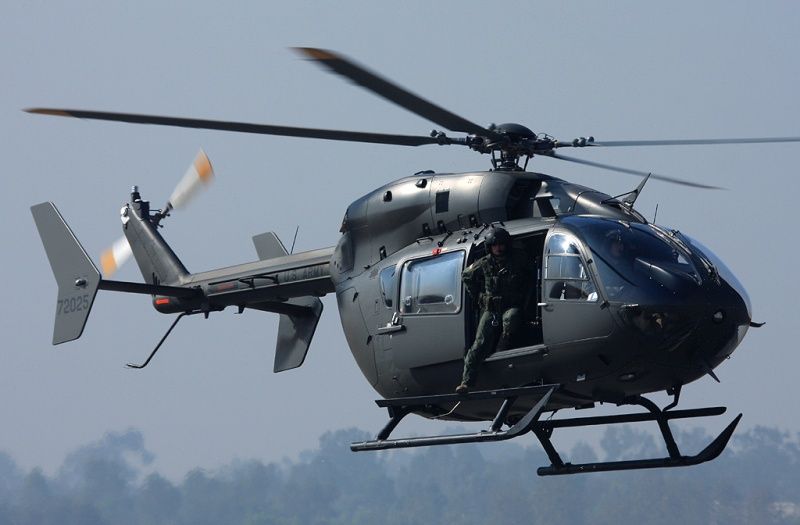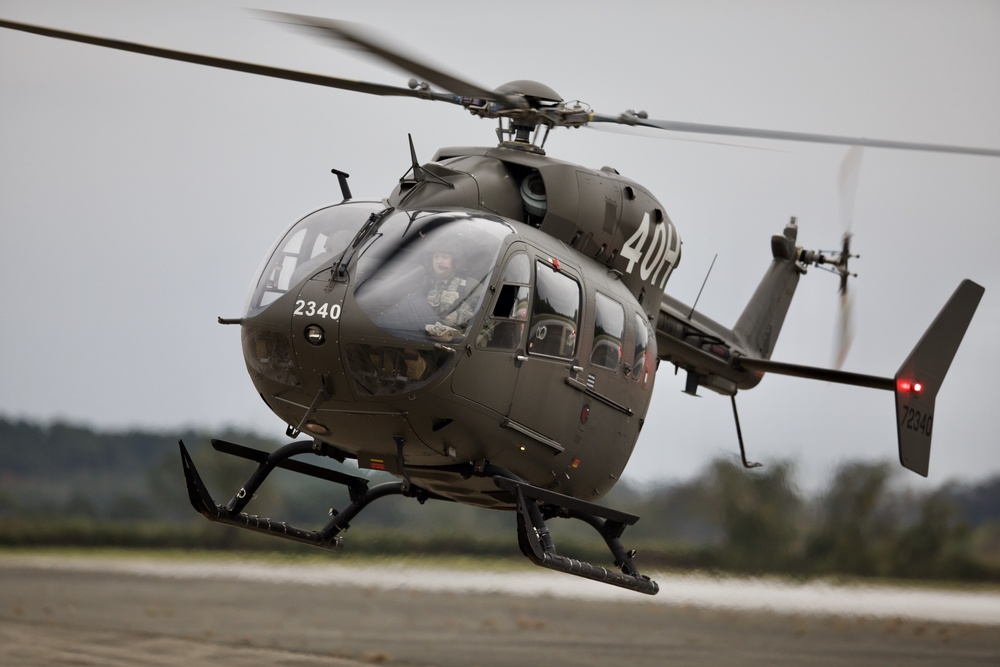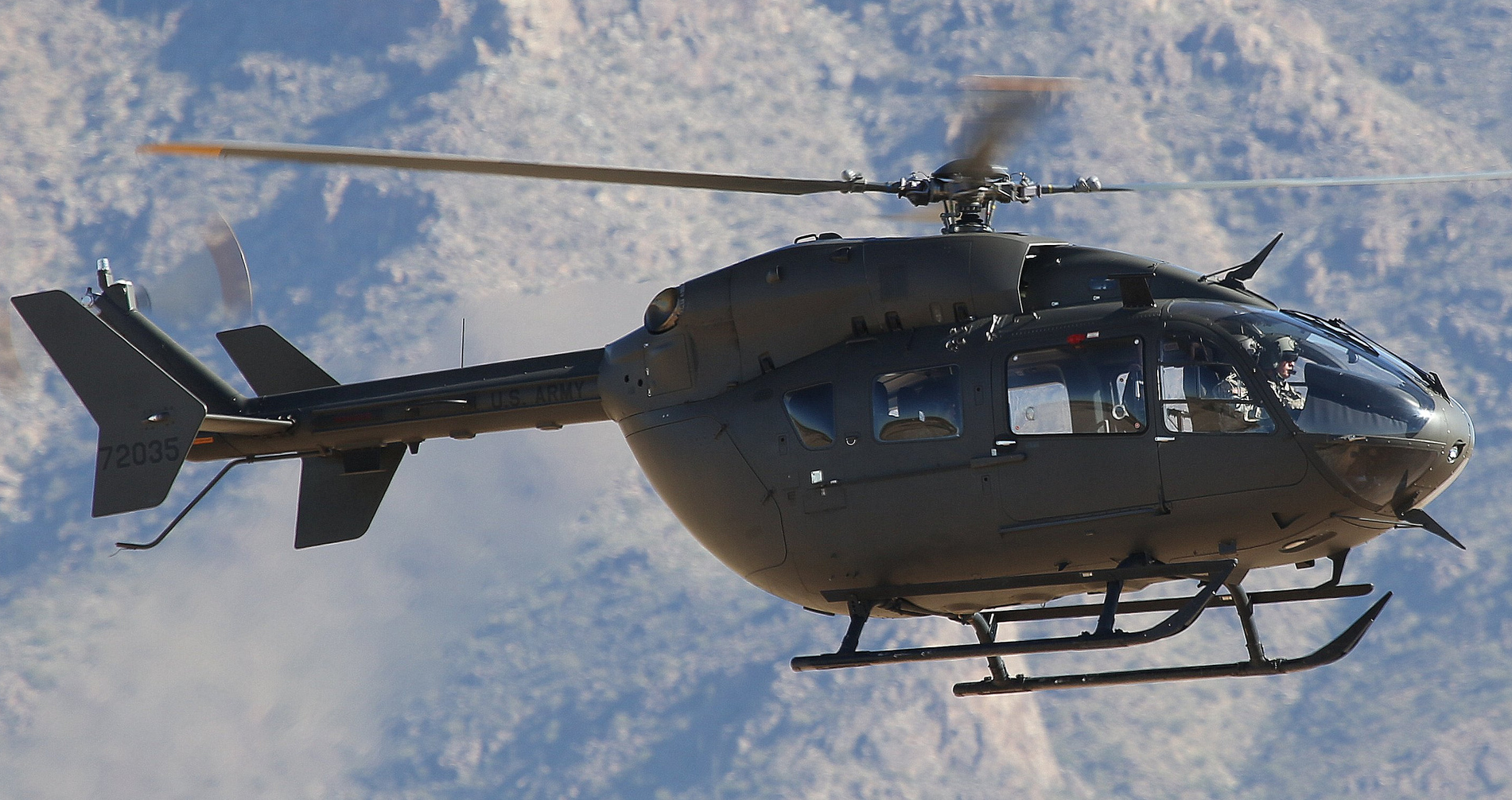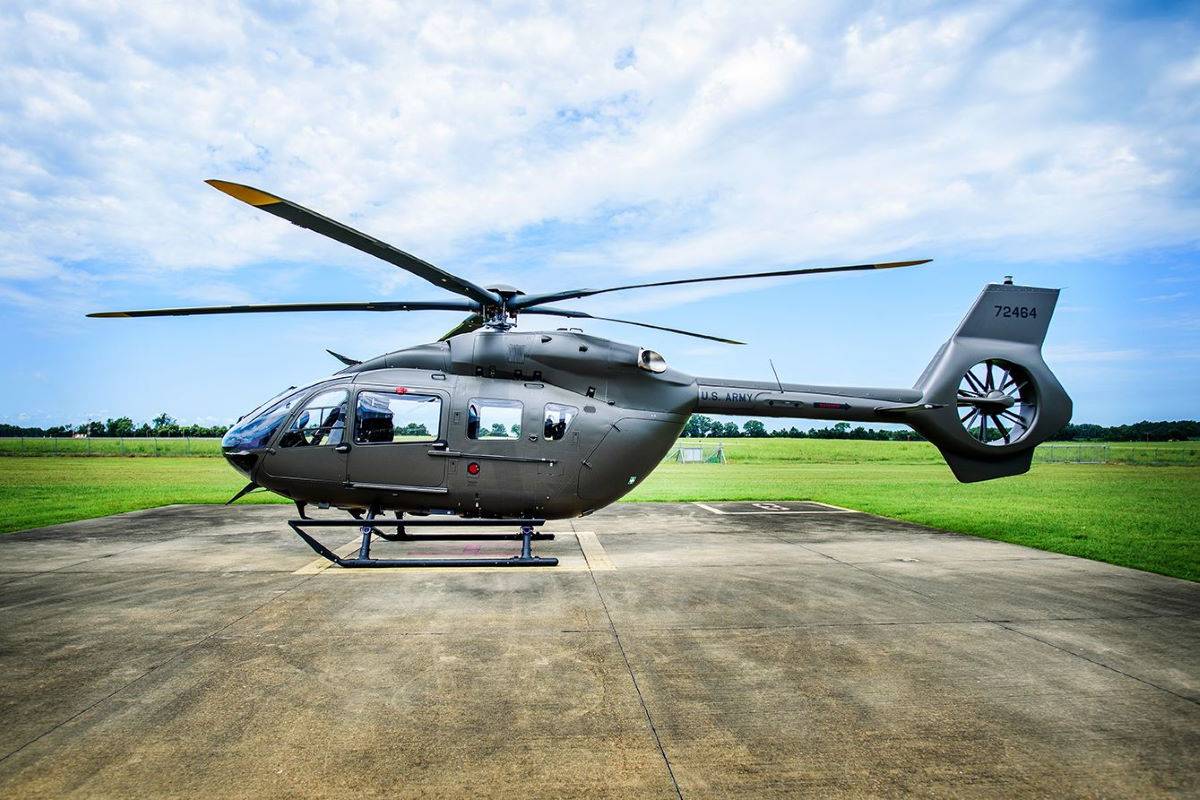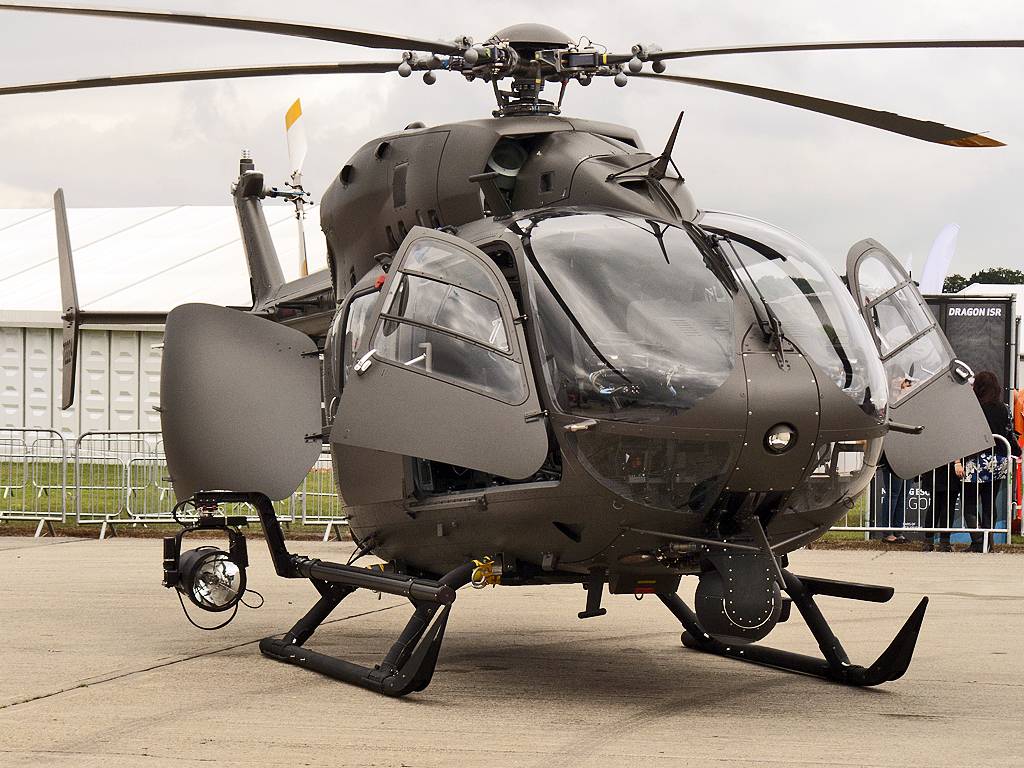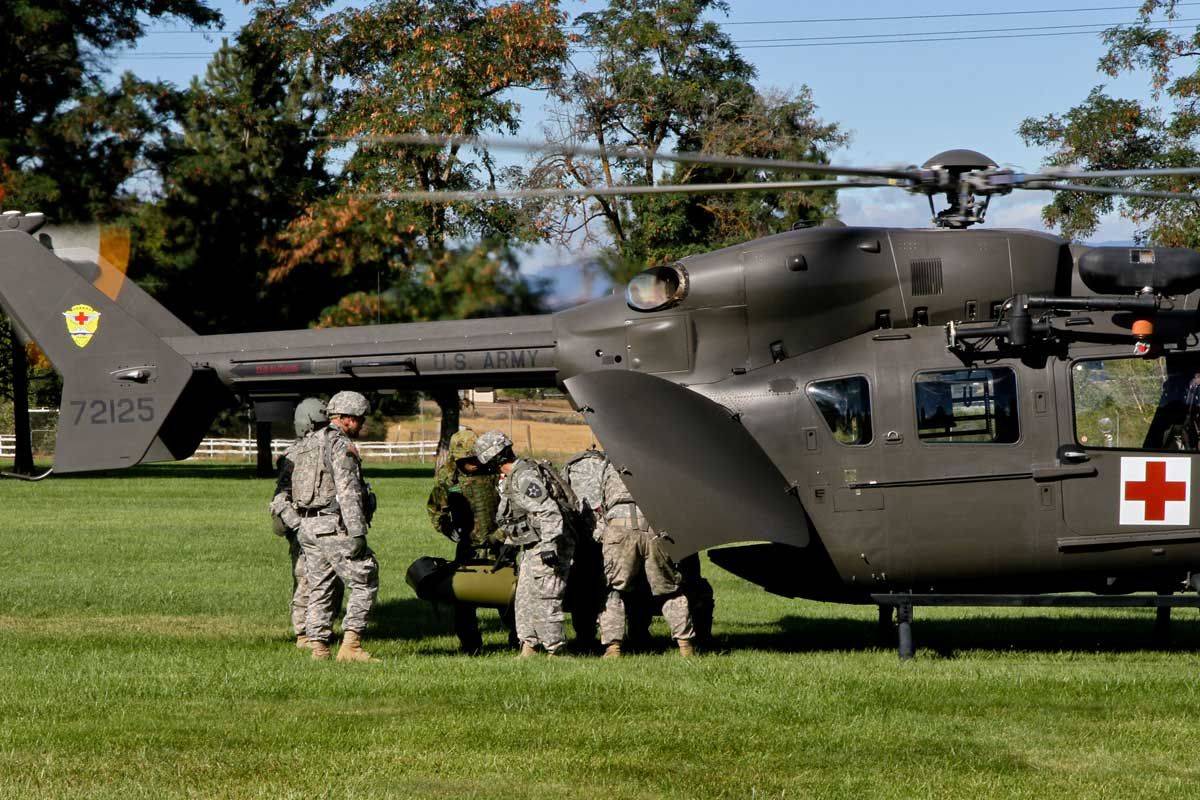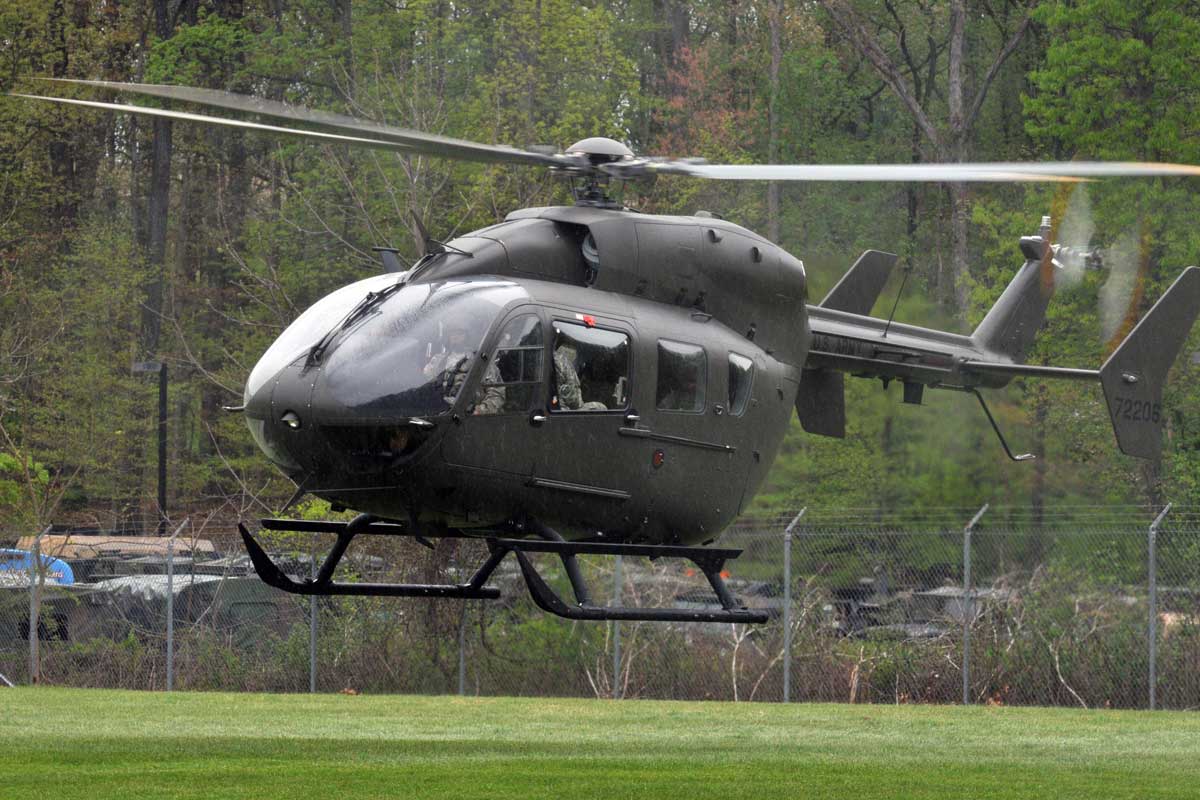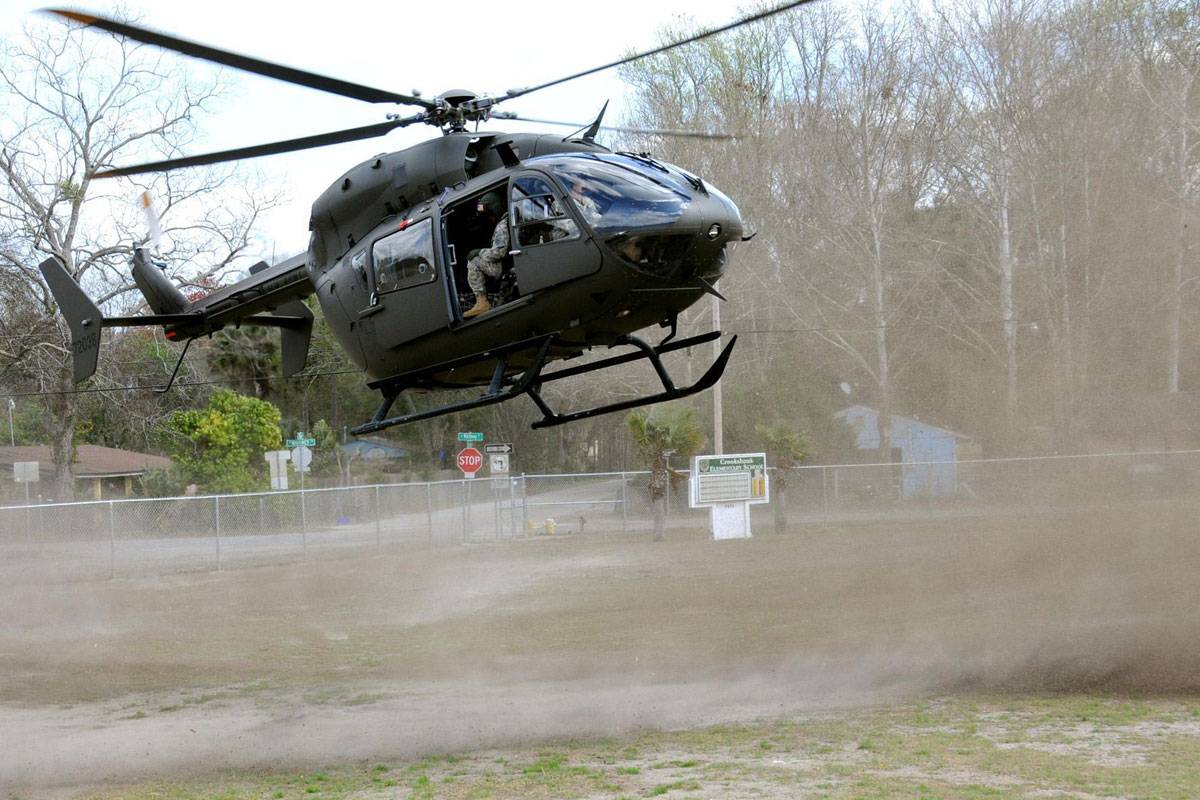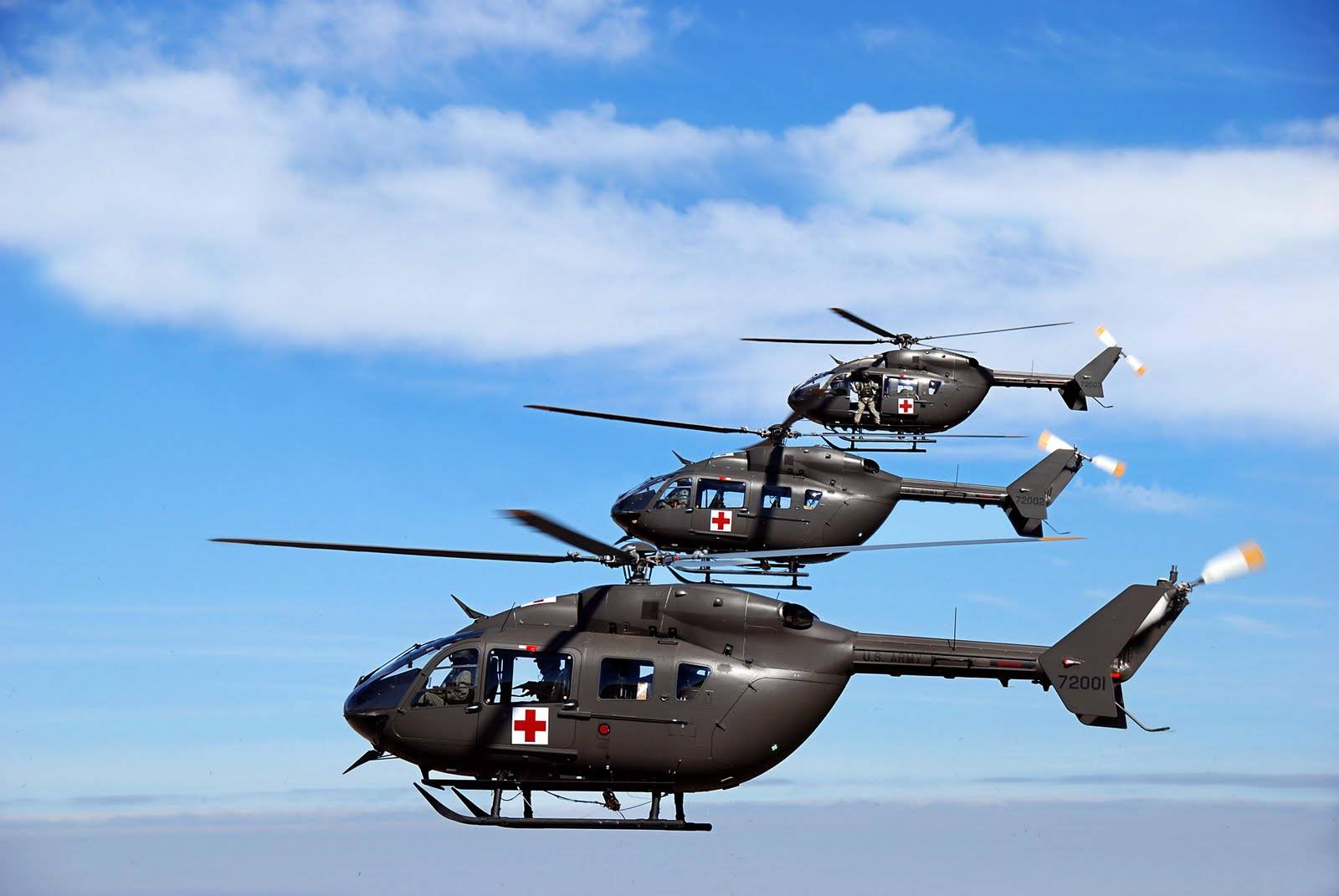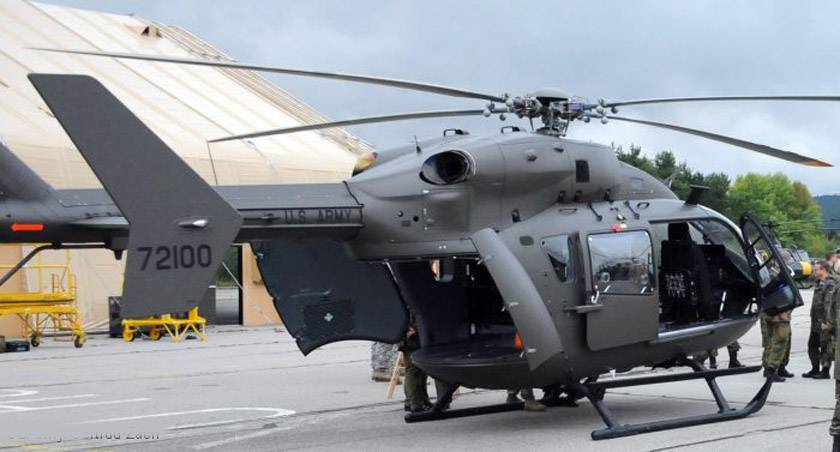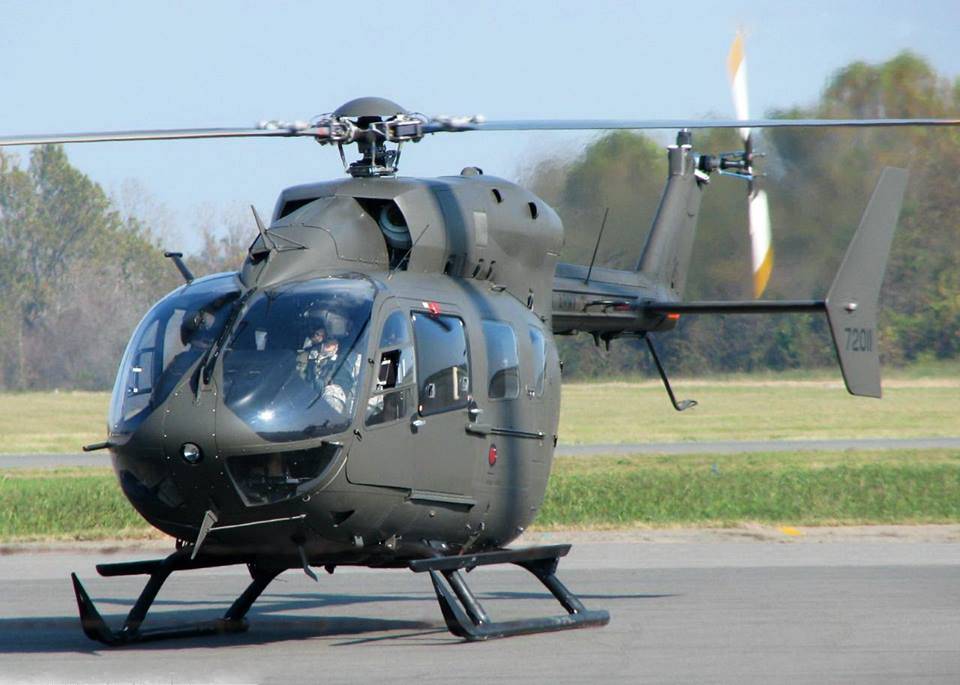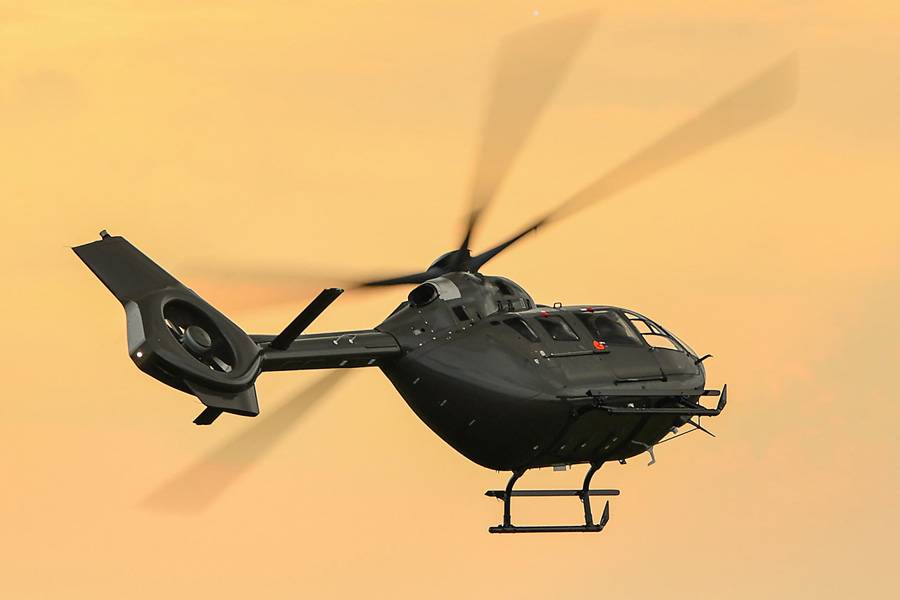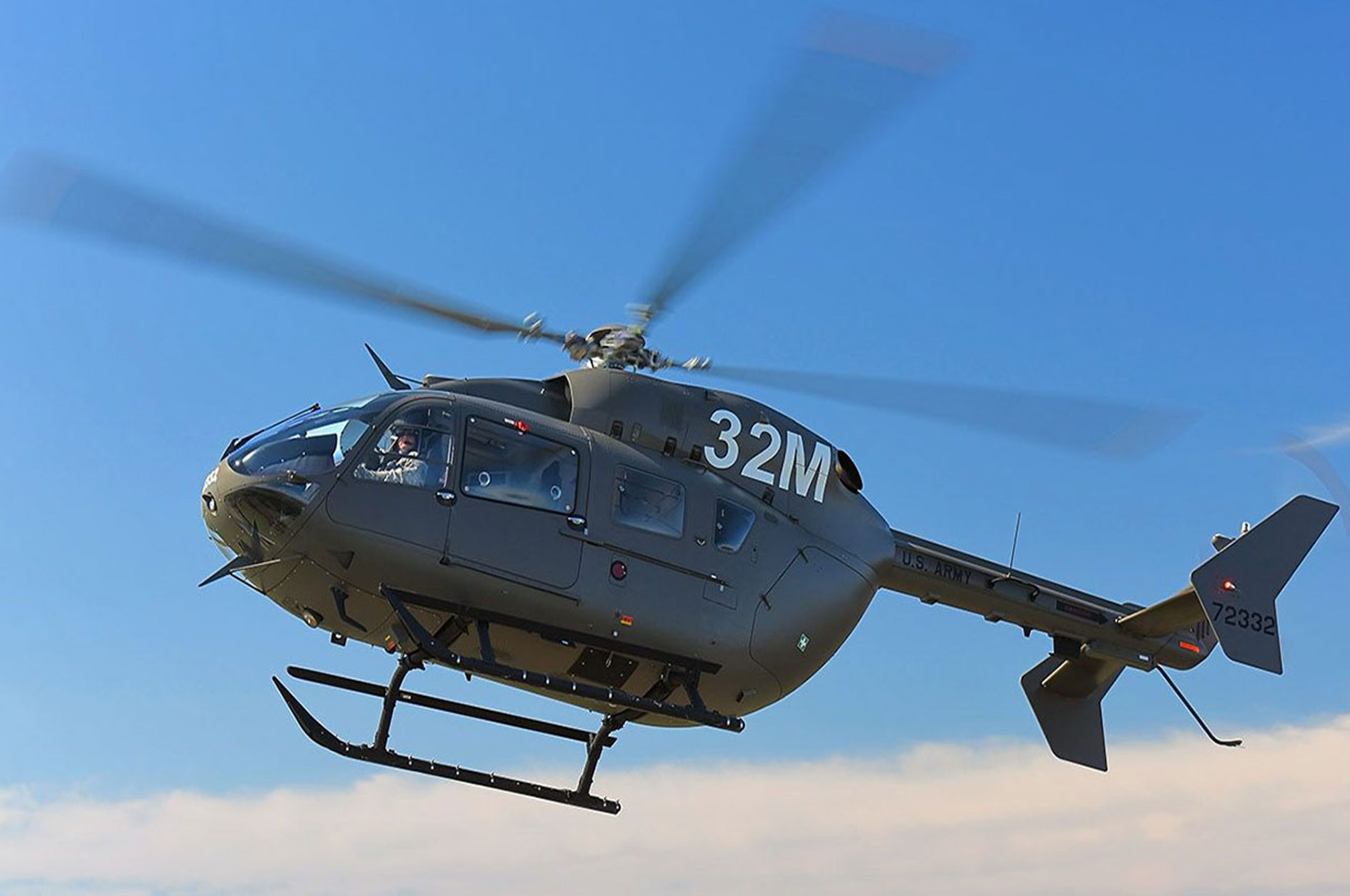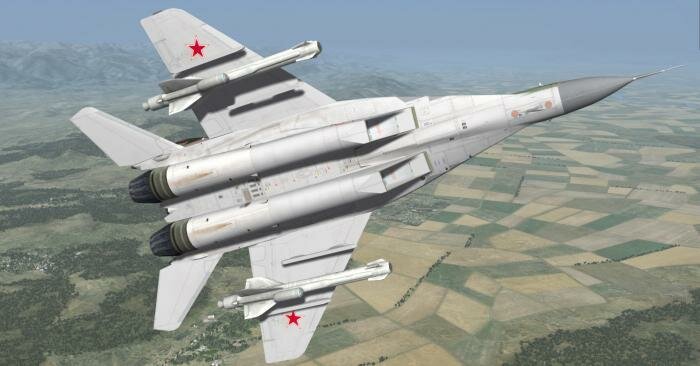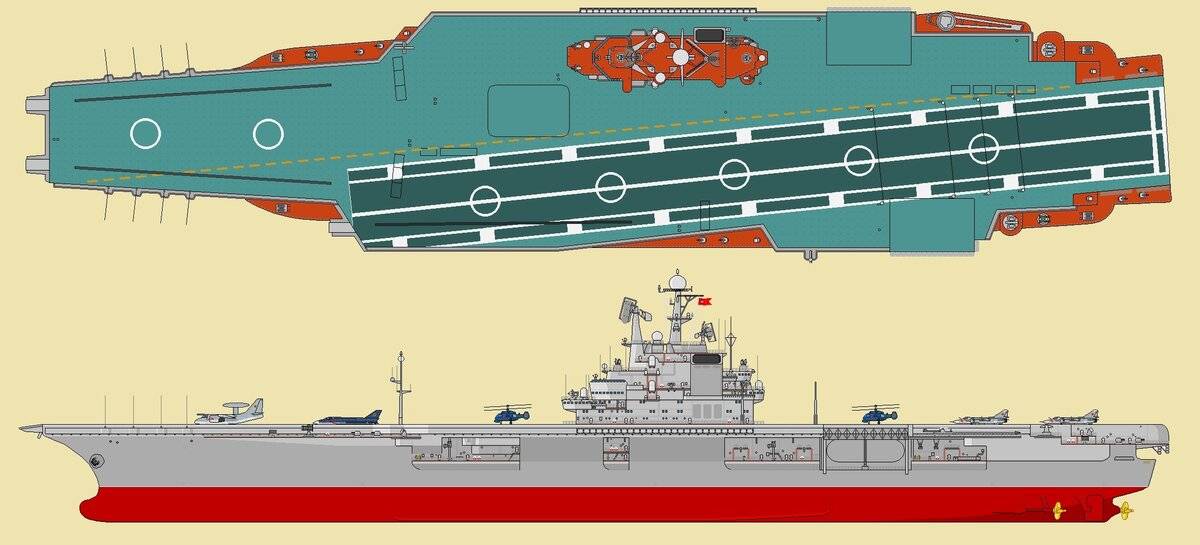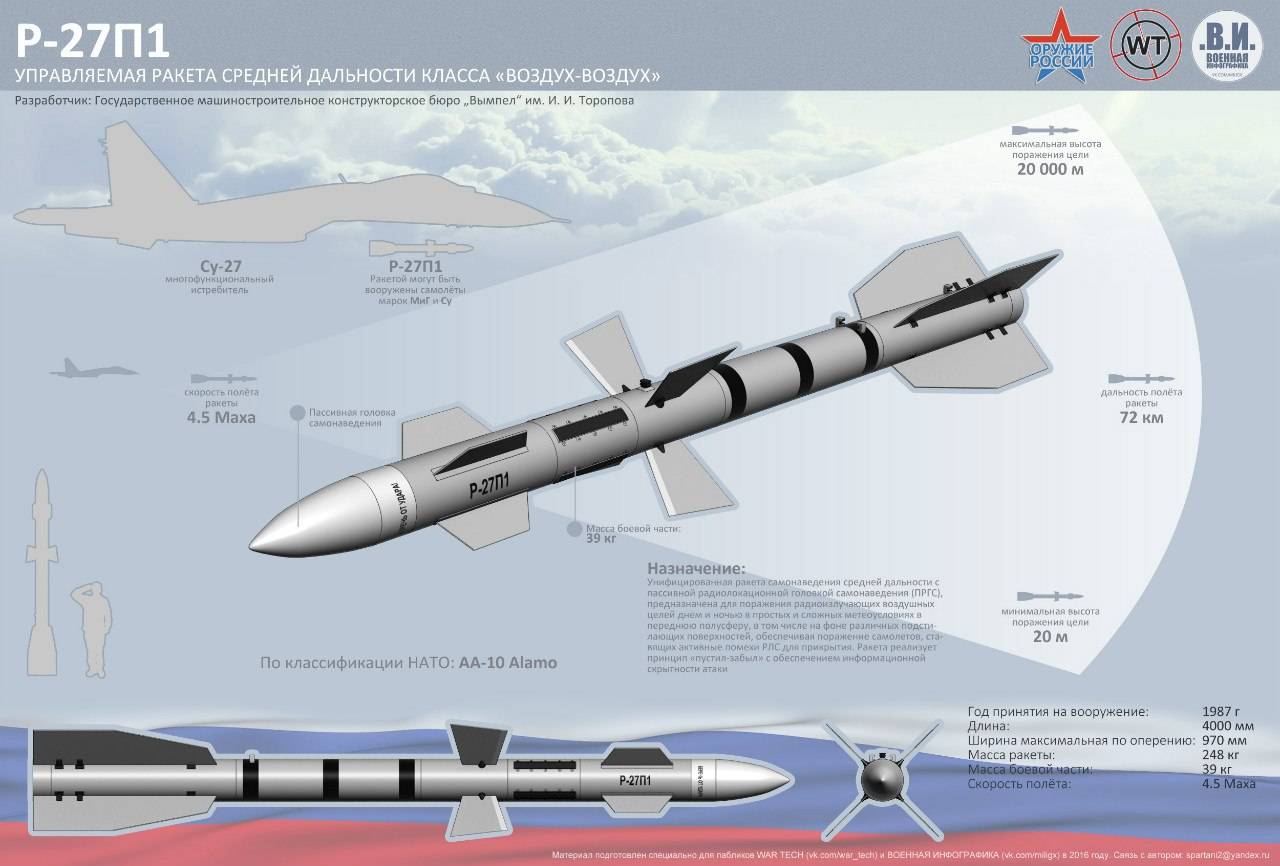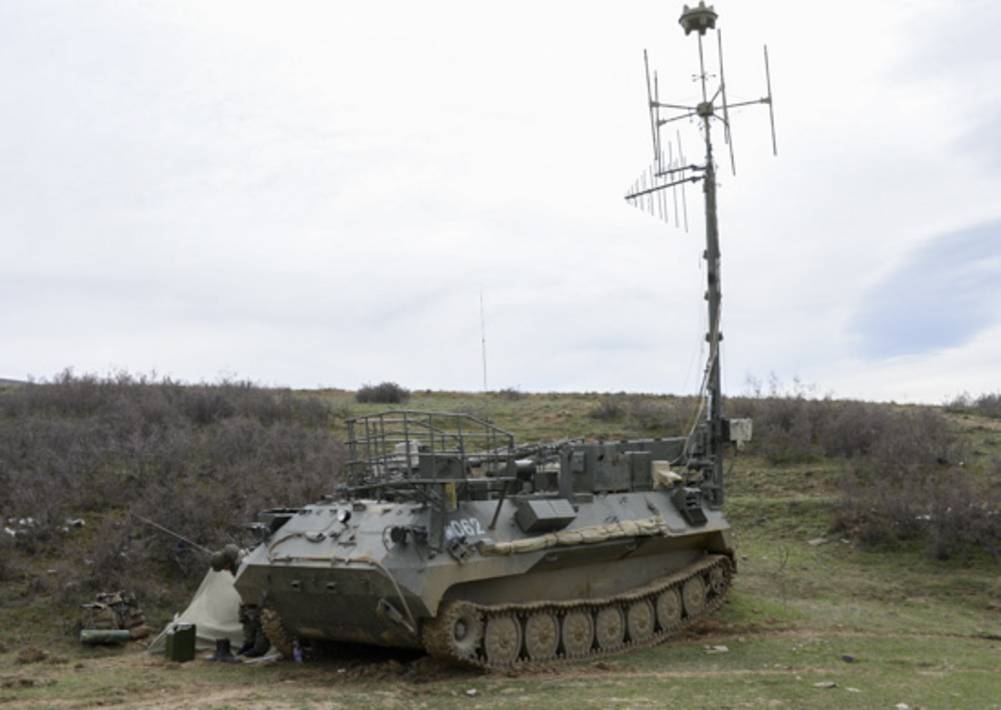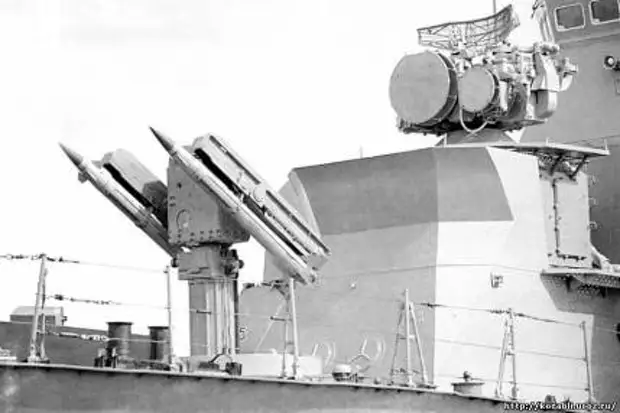Made for the Mission
The UH-72 Lakota is the U.S. Army’s multi-mission helicopter that has proven itself as a key platform for the U.S. Army, Navy, and National Guard in their mission of protecting and serving communities across America. Selected in June 2006 following a rigorous evaluation, it combines operational capability, reliability and affordability, fulfilling all of the Army’s requirements for speed, range, endurance and overall performance. As an in-production helicopter with FAA IFR certification, the UH-72 meets the Army’s commercial off-the-shelf (COTS) acquisition strategy.
The Lakota is based off the the technologically-advanced and operationally-proven H145 helicopter, which is used worldwide for law enforcement, emergency medical transportation, search and rescue, offshore and utility operations, and corporate transportation.
Incorporation of proven and new COTS technologies, combined with the UH-72’s operational capabilities, result in an aircraft that is exceptionally easy and affordable to operate and maintain. Extensive use of new, lightweight manufacturing materials and extensive system modularity simplifies maintenance, reducing lifetime ownership costs and logistics requirements.
2 x Turbomeca Arriel 1E2 turboshaft engines
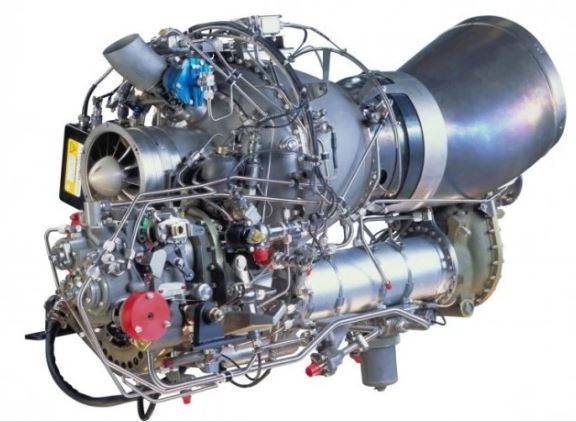
Arriel 1D1 / 1E2
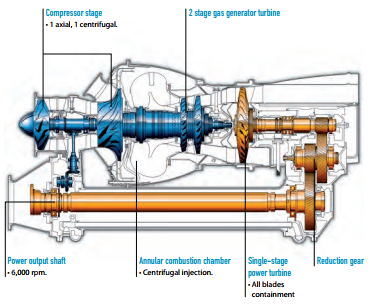
Arriel 1D1 and 1E2 engines are installed on various Airbus Helicopters models. The Arriel 1D1 powers the single-engine AS350B2 Ecureuil, while the Arriel 1E2 is aboard the twin-engine EC145 and BK 117C. The two variants build on the essential characteristics of every Arriel, namely, a modular design to simplify maintenance and an efficient and robust gas generator. As part of a contract awarded in July 2006 to power the UH-72A Lakota, a variant of the EC145 assembled at Airbus Helicopters Inc. in Columbus, Mississippi, more than 800 Arriel 1E2 engines are entering service with the US Army. The Arriel 1D1 delivers a take-off power of 732 shp and a cruising power of 625 shp. The Arriel 1E2, for its part, offers a take-off power of 738 shp and a cruising power of 692 shp. Its maximum power available in the One Engine Inoperative (OEI) rating is 771 shp.

Source safran-helicopter-engines.com
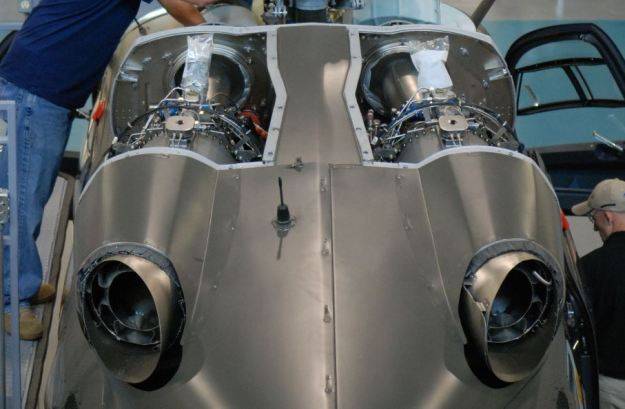
Airbus – cropped
CAE USA in Tampa, Florida, was contracted to design and manufacture UH-72A cockpit procedural trainers for the US Army, used for procedural, familiarisation, and transition training as the army begins taking delivery of the UH-72A helicopters.
Airbus Group also acquired the UH-72A cockpit procedural trainer to support pilot transition training at the Airbus Helicopters training centre in Grand Prairie, Texas.

deagel.com
UH-72A Lakota light utility helicopter orders and deliveries
A $43.1m contract was awarded to EADS North America in June 2006 for an initial order of eight helicopters. The army took delivery of the first UH-72A Lakota in December 2006. The first eight helicopters were delivered by July 2007. An additional order for 34 helicopters worth $170m was placed in October 2006 for delivery by late 2008.
The Lakota light utility helicopter entered service in June 2007. Full-rate production was authorised in August 2007.
The US Army’s requirement is for a total of 322 helicopters with a potential value of $2bn.
In October 2008, the US Navy placed an order for five Lakotas for training at the Naval Test Pilot School, Patuxent River, Maryland.
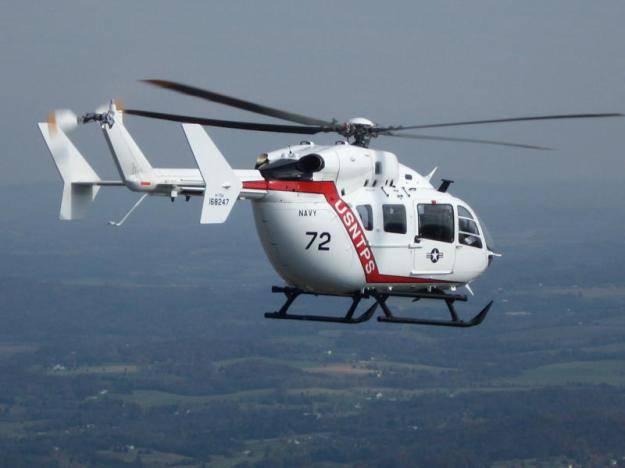
yeagerairport.com
In December 2008, the US Army ordered a further 39 Lakotas, extending production to the end of 2010. Five more were ordered in January 2009, bringing the total confirmed order for the army to 128. The 50th and 51st UH-72s were delivered in December 2008.
The US Army received two new UH-72A helicopters in January 2009 to replace its 38-year-old UH-1H Iroquois helicopters. The South Dakota Army National Guard received the first of six UH-72A helicopters in May 2011. The 200th Lakota was delivered to the US Army in March 2012.
In January 2012, EADS North America received a $212.7m contract from the US Army to deliver 39 UH-72A Lakota helicopters.
In November 2012, EADS North America received a $181.8m contract option from the US Army to deliver 34 UH-72A Lakota helicopters, bringing the total orders to 312.
The Utah Army National Guard received two new Lakotas in September 2013.
The US Army placed a $220.5m modification contract with Airbus Helicopters for the delivery of 41 UH-72A Lakota light utility helicopters, in February 2014.
Airbus delivered the first production-line configured UH-72A training helicopter to the US Army in March 2015.
The US Army awarded a $65.8m contract to Airbus for the delivery of 12 additional UH-72A helicopters and associated mission packages in November 2015.
Airbus secured a five-year contract worth approximately $1bn from the Army to provide spare parts and material and engineering support to the UH-72A fleet in December 2016.
The US Army awarded two contracts worth totalling $389m for the delivery of 51 UH-72A Lakota helicopters in March 2018.
Contractors involved
EADS North America selected companies such as LCX Systems, Sarasota, Fla; Sierra Nevada Corporation, Sparks, Nev; Ranger Rotorcraft Group, Fort Worth, Texas; MARK IV Luminator, Plano, Texas; and L-3 Communications, New York, for the security and support mission equipment package. The package includes an electro-optical infrared sensor, a data communications suite, moving map display, cabin and cockpit screens, a digital video recorder and a searchlight.
Sikorsky has been contracted to supply the UH-72A logistic support, including maintenance contract management, supply chain management, contractor field teams, spare part and tool management, facilities management and field and depot-level maintenance.
Main material source army-technology.com
Images are from public domain unless otherwise stated
Main image UH-72B by Airbus
Revised Sept 22, 2019
Updated Sept 09, 2021
Sikorsky S-97 Raider [2015]
Хотя он не находится на вооружении вооруженных сил США, этот список был бы неполным без невероятного Sikorsky S-97 raider. Построенный в соответствии с будущими требованиями армии США к вооруженному воздушному разведчику, Raider включает в себя множество новых технологий, которые позволяют ему преуспеть на поле боя и превзойти своих конкурентов. Наиболее заметной особенностью вертолета является его соосная несущая система, которая обычно используется на российских вертолетах Камова, и толкающий винт. Эта конструкция обеспечивает значительное улучшение по сравнению с обычной конструкцией вертолета, поскольку энергия не тратится впустую, пытаясь противодействовать вращению несущего винта с помощью рулевого винта. Вместо этого соосные несущие винты компенсируют крутящий момент друг друга и обеспечивают необходимую подъемную силу, в то время как толкающий винт обеспечивает переднюю тягу, что дает ему дополнительный толчок, необходимый для полета быстрее, чем его современники.
Рейдер может вместить 6 военнослужащих и нести ракетные капсулы под обрубками крыльев для обеспечения огневой поддержки. Максимальная скорость, которую он может развивать, составляет 444 км / ч, что позволит ему быстро входить и выходить из враждебных районов во время разведывательной или десантной миссии. Этот конкретный вертолет предназначен для спецназа США, поскольку он может быть полезен для быстрой переброски и эвакуации войск. Поступит ли он на самом деле на вооружение вооруженных сил США или нет, остается предметом спекуляций, но этот дизайн определенно будет усовершенствован, и мы увидим похожие вертолеты в ближайшие десятилетия.
#топ 10 #технологии #история #исторические факты #сша #военные #военный #техника #соединенные штаты америки #военная техника
Raytheon AN/ARC-231 aircraft voice and data radio
The AN/ARC-231 Skyfire airborne software-defined radio from the Raytheon Co. Integrated Defense systems segment in Marlborough, Mass., is a line-of-sight VHF and UHF radio, as well as a satellite communications (SATCOM) terminal.
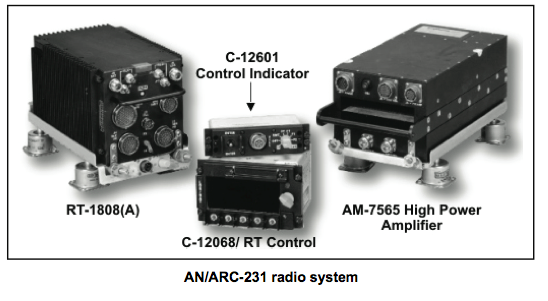
The Raytheon Skyfire aircraft radio is on military helicopters ranging from the MH-60L/M and UH-60L/M Black Hawks, MH-47E/G and CH-47G Chinooks, UH-1N Hueys, A2C2S Black Hawks, and AH-64 Apaches, as well as the UH-72A Lakotas. The radio also is on several military fixed-wing aircraft.
The ARC-231 operates on frequencies from 30 to 512 MHz, with frequency agile modes electronic counter-countermeasures (ECCM), UHF SATCOM, demand assigned multiple access (DAMA), integrated waveform (IW), and air traffic control (ATC).
Data communications that sends and receives text, still images, and video, uses an internal data controller, and sends data as fast as 56, 64, and 76.8 kilobits per second. Source militaryaerospace.com
The UH-72A’s tactical communications system includes an RT-5000 wideband transceiver operating at 29MHz to 960MHz, and dual P-2000 tactical communications transceivers. Wulfsberg Electronics also supplies navigation and communications systems for EC145 helicopters used in civilian and special mission roles.
UH-72A Lakota light utility helicopter design
The UH-72A Lakota light utility helicopter is a military version of the Eurocopter EC145. During the competitive bidding phase, EADS North America used the UH-145 designation for its light utility helicopter entry. The helicopters were manufactured by Airbus Helicopters at the company’s production centre in Columbus, Mississippi.
The main and tail rotors are high set to allow fast and safe loading and unloading through the main doors and rear-fuselage clamshell doors, even while the rotors are turning. The helicopter has a hingeless rotor system with composite main rotor blades which are 11m in diameter. The rotor configuration provides reduced noise and vibration characteristics. The high-set, twin-blade tail rotor has a diameter of 1.95m.
Safety features include a high level of redundancy with a twin-engine design, and redundant hydraulic, electrical and engine control systems. The crashworthy airframe and seats also contribute to the UH-72A’s operational safety and survivability.
Navigation, communications and cabin of UH-72A
UH-72A Lakota light utility helicopter’s navigation and communications systems were supplied by Wulfsberg Electronics based in Prescott, Arizona. The navigation and air traffic control communications include dual VHF communications transceivers, dual VHF navigation receivers with VOR, ILS and marker beacon, and a DME transceiver.
The UH-72A’s tactical communications system includes an RT-5000 wideband transceiver operating at 29MHz to 960MHz, and dual P-2000 tactical communications transceivers. Wulfsberg Electronics also supplies navigation and communications systems for EC145 helicopters used in civilian and special mission roles.
The cabin accommodates eight troops or passengers. The cabin is fitted with BAE System’s Simula passenger seats which are of fold-up design and meet FAA crashworthiness standards. The cockpit and passenger seats are of high strength, lightweight composites construction and include aramid and graphite materials.
The cockpit and cabin are fitted with a heating and ventilating system supplied by Keith Products. The Keith Products heating, ventilation and cooling systems are fitted as standard equipment for all civilian EC145 versions of the Lakota UH-72A.
UH-72A
U.S. Army pilots benefit from the UH-72A’s VEMD (Vehicle and Engine Multifunction Display) and its night vision goggle (NVG) compatible glass cockpit, which synthesizes flight and vehicle information, increasing situational awareness and reducing crew workload.
The Lakota’s redundant hydraulic, electrical, and engine control systems – combined with its crashworthy airframe and energy-attenuating pilot and passenger seats – add a high level of flight safety and survivability to the type’s exceptional flight characteristics. Power from the aircraft’s reliable Arriel turboshafts is delivered through a proven hingeless rotor system to the UH-72A’s advanced technology composite rotor blades. Coupled with advanced blade design, this decreases vibration and noise, while enhancing aerodynamic efficiency and mission performance.
The UH-72A’s unobstructed main cabin is easily re-configurable to maximize mission flexibility. The helicopter’s sliding side and rear clamshell doors optimize access and effective space utilization, offering rapid troop deployment and substantial mission growth potential. The Lakota can carry up to nine troops on crashworthy seats, while two stretchers can be installed for MEDEVAC missions.
definition – Eurocopter UH-72 Lacota
of Wikipedia
Advertizing ▼
Wikipedia
Eurocopter UH-72 Lacota
Материал из Википедии — свободной энциклопедии
Перейти к: ,
| UH-72 Lacota | |
|---|---|
| UH-72 | |
| Тип | транспортный вертолёт |
| Разработчик | Eurocopter |
| Производитель | American Eurocopter |
| Начало эксплуатации | |
| Статус | эксплуатируется |
| Основные эксплуатанты | Армия США |
| Базовая модель | Eurocopter EC 145 |
| Изображения на Викискладе |
UH-72 Lacota — Многоцелевой вертолет.
UH-72A создан на основе многоцелевого вертолета EC145 концерна Eurocopter (разработка компании “Messerschmitt-Belkow-Blohm”), европейским концерном EADS. Первый полет совершил в 2006 году.
Вооруженные силы США планируют приобрести 332 вертолета UH-72A.
Тактико-технические характеристики
UH-72 Lakota der US Army
Файл:EC 145.ogg Flugvorführung EC 145
Приведенные характеристики соответствуют модификации UH-72A.
Источник данных: American Eurocopter, Jane’s
Технические характеристики
- Экипаж: 1-2 пилота
- Пассажировместимость: до 9 солдат
- Грузоподъёмность: 2 500 кг (вариант TTH)
- Длина: 13,03 м
- Длина фюзеляжа: 10,19 м
- Диаметр несущего винта: 11,0 м
- Диаметр рулевого винта: 1,96 м
- Максимальная ширина фюзеляжа: 1,84 м
- Высота: 3,96 м (с хвостовым винтом)
- Площадь, ометаемая несущим винтом: 95,03 м²
- Колея шасси: 2,4 м
- Масса пустого: 1 792 кг
- Максимальная взлётная масса: 3 585 кг
- Масса полезной нагрузки: 1 793 кг
- Объём топливных баков: 867 л
- Силовая установка: 2 × турбовальных Turbomeca Arriel 1E2
- Мощность двигателей: 2 × 738 л.с. (2 × 550 кВт (взлётная))
Лётные характеристики
- Максимальная скорость: 268,5 км/ч
- Практическая дальность: 685 км
- Практический потолок: 4 018 м
- Статический потолок:
- с использованием эффекта земли: 3 444 м
- без использования эффекта земли: 2 743 м
- Скороподъёмность: 8,1 м/с
Примечания
- Jane’s All The World’s Aircraft 2004-2005 / Paul Jackson. — Jane’s Information Group, 2004. — P. 272-273. — 860 p. — ISBN 0-7106-2614-2
См. также
- Родственные разработки
- MBB BK 117
- Eurocopter EC 135
- Eurocopter EC 145
- Аналоги
- Bell ARH-70
- Bell UH-1 Iroquois
- Bell OH-58 Kiowa
- Sikorsky UH-60 Black Hawk
- Списки
Список вертолётов
| Файл:Air template.gif | Это незавершённая статья об авиации. Вы можете помочь проекту, исправив и дополнив её. |
UH-72A Lakota light utility helicopter orders and deliveries
A $43.1m contract was awarded to EADS North America in June 2006 for an initial order of eight helicopters. The army took delivery of the first UH-72A Lakota in December 2006. The first eight helicopters were delivered by July 2007. An additional order for 34 helicopters worth $170m was placed in October 2006 for delivery by late 2008.
The Lakota light utility helicopter entered service in June 2007. Full-rate production was authorised in August 2007.
The US Army’s requirement is for a total of 322 helicopters with a potential value of $2bn.
In October 2008, the US Navy placed an order for five Lakotas for training at the Naval Test Pilot School, Patuxent River, Maryland.
In December 2008, the US Army ordered a further 39 Lakotas, extending production to the end of 2010. Five more were ordered in January 2009, bringing the total confirmed order for the army to 128. The 50th and 51st UH-72s were delivered in December 2008.
The US Army received two new UH-72A helicopters in January 2009 to replace its 38-year-old UH-1H Iroquois helicopters. The South Dakota Army National Guard received the first of six UH-72A helicopters in May 2011. The 200th Lakota was delivered to the US Army in March 2012.
In January 2012, EADS North America received a $212.7m contract from the US Army to deliver 39 UH-72A Lakota helicopters.
In November 2012, EADS North America received a $181.8m contract option from the US Army to deliver 34 UH-72A Lakota helicopters, bringing the total orders to 312.
The Utah Army National Guard received two new Lakotas in September 2013.
The US Army placed a $220.5m modification contract with Airbus Helicopters for the delivery of 41 UH-72A Lakota light utility helicopters, in February 2014.
Airbus delivered six UH-72A Lakotas to the Royal Thai Army in 2014 under the US’s foreign military sales programme.
Airbus delivered the first production-line configured UH-72A training helicopter to the US Army in March 2015.
The US Army awarded a $65.8m contract to Airbus for the delivery of 12 additional UH-72A helicopters and associated mission packages in November 2015.
Airbus secured a five-year contract worth approximately $1bn from the Army to provide spare parts and material and engineering support to the UH-72A fleet in December 2016.
The US Army awarded two contracts worth totalling $389m for the delivery of 51 UH-72A Lakota helicopters in March 2018. Airbus delivered the 200th UH-72A Lakota to the Army Aviation Center of Excellence at Fort Rucker, Alabama, in August 2019.
The US Army placed a $122m order for 15 UH-72A Lakota training and support platforms in March 2020, which are scheduled to be delivered by August 2022.
The Utility Helicopters Project Management Office of the US Army received a total of 16 UH-72A helicopters in 2020. In September 2021, Airbus handed over the first UH-72B variant to the US Army National Guard, under a contract with the National Guard to deliver 18 UH-72Bs.
UH-72B
In 2020 the Army placed a new order for the latest variant of the Lakota family of aircraft – the UH-72B. Part of the proven H145 family of aircraft, the UH-72B Lakota is the latest iteration of the same commercial, off-the-shelf aircraft that has been the Army’s multi-mission helicopter since the first Lakota contract award in 2006.
The Army is leveraging the benefits of a COTS program by receiving product improvements and enhancements through the evolution of the aircraft, without investing any government money into the research & development of those capabilities.
The UH-72B benefits from numerous product improvements developed during the lifecycle of the commercial aircraft that have increased the power, controls and safety of the Lakota.
A Fenestron shrouded tail rotor comes with a newly designed gearbox that reduces maintenance and enhances safety for ground operations. And a new bearingless, five-bladed rotor increases the aircraft’s load capacity while reducing expense and maintenance.
An enhanced Arriel 2E power plant and dual FADEC generates even more power, and a four-axis autopilot strengthens controls and allows for automated takeoffs. An auxiliary operator’s console allows central control of electro-optical sensors, spotlight and ground data link as part of the security and support mission equipment package.
Pilots benefit from the advanced Airbus Helionix avionics suite, which provides the most innovative and intuitive human-machine interface.
Like its predecessor, the UH-72B is built at an Airbus Helicopters Inc., production facility in Columbus, Mississippi, where the workforce is comprised of more than 30% veterans.
Исторический
UH-72 из из 121 – я медицинской роты Национальной гвардии округа Колумбии в 2009 году.
Один из 5 самолетов UH-72A из вертолетной школы ВМС США.
Лакота на Парижском авиасалоне 2015 года.
Первоначально обозначенный как UH-145 , вертолет был выбран в результате тендера на легкий служебный вертолет армии США (LUH) 30 июня 2006 года. В октябре 2006 года американский Eurocopter подписывает контракт на поставку 345 самолетов для замены устаревшего UH-1H. и OH-58A / C на вооружении армии США и национальной гвардии .
В оборонном бюджете США на 2011 год планировалось заказать 50 единиц на сумму 303,5 миллиона долларов США; в 2012 году – 39 на 250,4 миллиона долларов, а в 2013 году – 34 на 272 миллиона долларов.
В ноябре 2012 года был размещен заказ на 34 самолета на сумму 181,8 миллиона долларов. На данный момент доставлено 243 экземпляра.
На начало марта 2014 года ВМС США было поставлено 296 машин, в том числе 5. В то время как армия США должна была получить в общей сложности 345 Lakota к 2016 году, проект бюджета на 2015 год предусматривает 424 UH-72 Lakota.
В ноябре 2015 года с завода сошло 338 экземпляров. Ожидается, что 187 будут служить в качестве учебных устройств для замены TH-67 Creek, специальной версии Bell 206 .
В феврале 2018 года было доставлено 412 ранее заказанных копий, еще 35 были заказаны в начале марта за 273 миллиона долларов.
В январе 2019 года 435 самолетов из 478, предусмотренных контрактами с армией США, были поставлены почти на 3,5 миллиарда долларов: последний самолет должен покинуть завод в 2021 году. Airbus надеется к тому времени выиграть контракт для ВМС США на 130 самолетов. легкие учебные вертолеты, предназначенные для замены старых TH-57, но был выбран AgustaWestland AW119 Koala .
Mission systems aboard UH-72A
The modular design of the UH-72A Lakota light utility helicopter allows the fast and efficient installation of a range of mission modules.
For ambulance and medical evacuation missions, the cabin can accommodate two stretchers, plus one crew chief (who is qualified to operate the hoist and other aircraft equipment) and one medical attendant. The UH-72A’s Nato standard stretchers and stretcher retainer mounts were supplied by Aerolite of Washington.
The UH-72A Lakota light utility helicopter has an externally mounted rescue electric hoist, series type 44301 from Goodrich. The hoist is mounted on a boom and support assembly that allows it to be positioned in an arc of up to 63° from the aircraft fuselage centreline for maximum operational flexibility. The hoist is stowed in line with the fuselage during flight.
P-2000 tactical communications transceivers
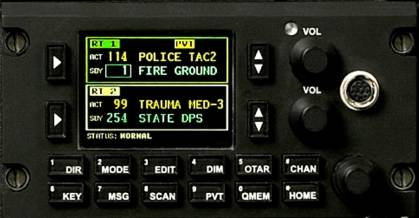
The cabin accommodates eight troops or passengers. The cabin is fitted with BAE System’s Simula passenger seats which are of fold-up design and meet FAA crashworthiness standards. The cockpit and passenger seats are of high strength, lightweight composites construction and include aramid and graphite materials.
The cockpit and cabin are fitted with a heating and ventilating system supplied by Keith Products. The Keith Products heating, ventilation and cooling systems are fitted as standard equipment for all civilian EC145 versions of the Lakota UH-72A.
Mission systems
The modular design of the UH-72A Lakota light utility helicopter allows the fast and efficient installation of a range of mission modules.
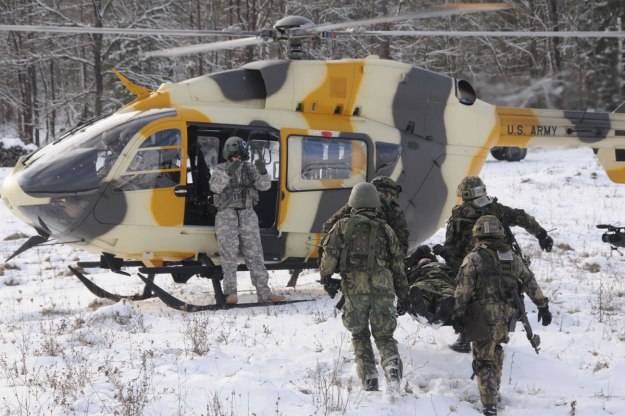
military.com
For ambulance and medical evacuation missions, the cabin can accommodate two stretchers, plus one crew chief (who is qualified to operate the hoist and other aircraft equipment) and one medical attendant. The UH-72A’s Nato standard stretchers and stretcher retainer mounts are supplied by Aerolite of Washington.

Joe A. Kunzler @flicker
The UH-72A Lakota light utility helicopter has an externally mounted rescue electric hoist, series type 44301 from Goodrich Corporation. The hoist is mounted on a boom and support assembly that allows it to be positioned in an arc of up to 63° from the aircraft fuselage centreline for maximum operational flexibility. The hoist is stowed in line with the fuselage during flight.

militarysystems-tech.com
Turbomeca Arriel 1E2 turboshaft engines and flight training
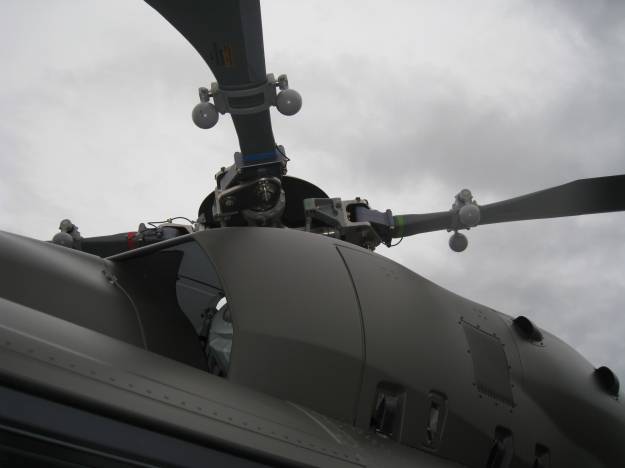
Howard Mason @primeportal.net
The helicopter is powered by two Turbomeca Arriel 1E2 turboshaft engines, each providing 550kW of take-off power and 516kW continuous power.
The engines are rated to provide a maximum power of 574kW for two and a half minutes and 404kW continuously in one-engine-inoperable-mode fight.
Turbomeca Arriel 1E2 turboshaft engines and flight training
The helicopter is powered by two Turbomeca Arriel 1E2 turboshaft engines, each providing 550kW of take-off power and 516kW continuous power.
The engines are rated to provide a maximum power of 574kW for two and a half minutes and 404kW continuously in one-engine-inoperable-mode fight.
CAE USA in Tampa, Florida, was contracted to design and manufacture UH-72A cockpit procedural trainers for the US Army, used for procedural, familiarisation, and transition training as the army begins taking delivery of the UH-72A helicopters.
Airbus Group also acquired the UH-72A cockpit procedural trainer to support pilot transition training at the Airbus Helicopters training centre in Grand Prairie, Texas.
Contractors involved
EADS North America selected companies such as LCX Systems, Sierra Nevada Corporation (SNC), Ranger Rotorcraft Group, MARK IV Luminator, and L-3 Communications (now L3Harris) for the security and support mission equipment package. The package includes an electro-optical infrared sensor, a data communications suite, moving map display, cabin and cockpit screens, a digital video recorder and a searchlight.
Sikorsky was contracted to supply the UH-72A logistic support, including maintenance contract management, supply chain management, contractor field teams, spare part and tool management, facilities management and field and depot-level maintenance.
Safran Electronics & Defense, Avionics was selected to provide avionics systems for the UH-72A helicopters.
Cockpit and avionics systems
The cockpit and cabin of the UH-72A Lakota light utility helicopter are fitted with a large multipiece wrap-around front windscreen, multiple side-fuselage windows on the cockpit and passenger doors, and side windows for the main cabin. The windows and windscreen, supplied by Nordam Group in Tulsa, Oklahoma, provide good visibility for the helicopter’s crew and passengers.
The cockpit accommodates a crew of two and is fitted with two Simula energy-absorbing cockpit seats supplied by BAE Systems Mobility and Protection Systems (formerly Armor Holdings Aerospace and Defense Group). The cockpit seats have ergonomic cushions, a four-point restraint system with an inertia reel and are qualified to FAA crashworthiness standards.
UH-72A is fitted with a night-vision goggle-compatible glass cockpit with active-matrix liquid crystal displays and a Meghas avionics suite supplied by Thales US. The cockpit displays include the Thales centralised vehicle and engine management display (VEMD).
The cockpit displays simplify the presentation of flight and vehicle information, increasing the crew’s situational awareness and reducing the pilot’s workload.
Production of the Meghas avionics suite was transferred from Europe to a new Thales production facility in Irvine, California.
The helicopter’s automatic flight control system was supplied by Sagem Avionics and was partially produced at the company’s Grand Prairie, Texas, facility.
UH-72A Lakota light utility helicopter’s automatic flight control system includes two attitude and heading reference systems (AHRS), advanced power management (APM) computers, smart electro-mechanical actuators, TRIM actuators and fibre-optic gyroscopes.
The avionics cooling system, supplied by Keith Products of Addison, Texas, ensures proper operating temperatures for the helicopter’s navigation, communications and mission equipment.

